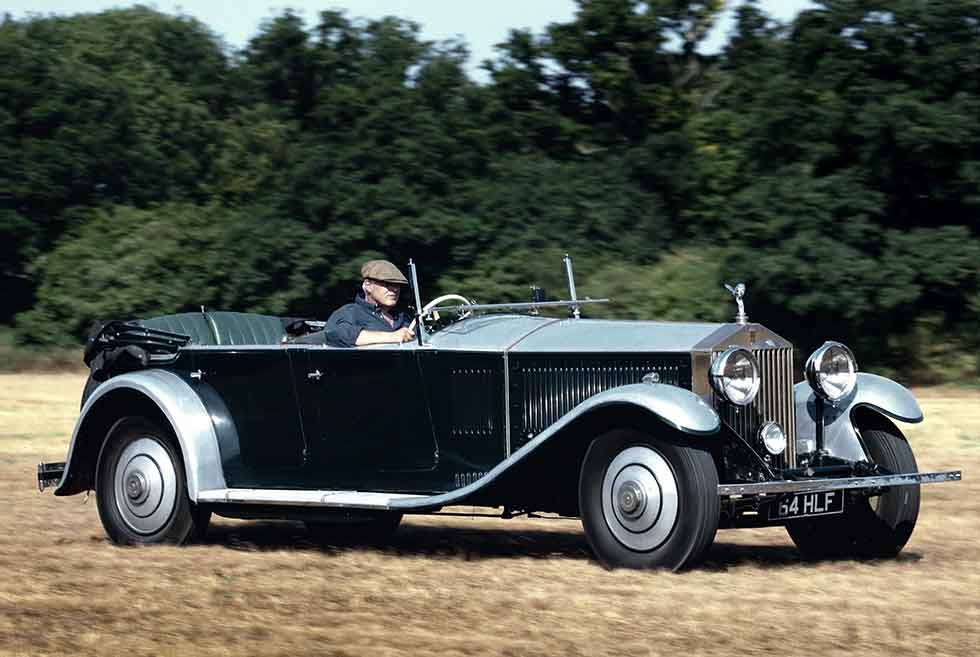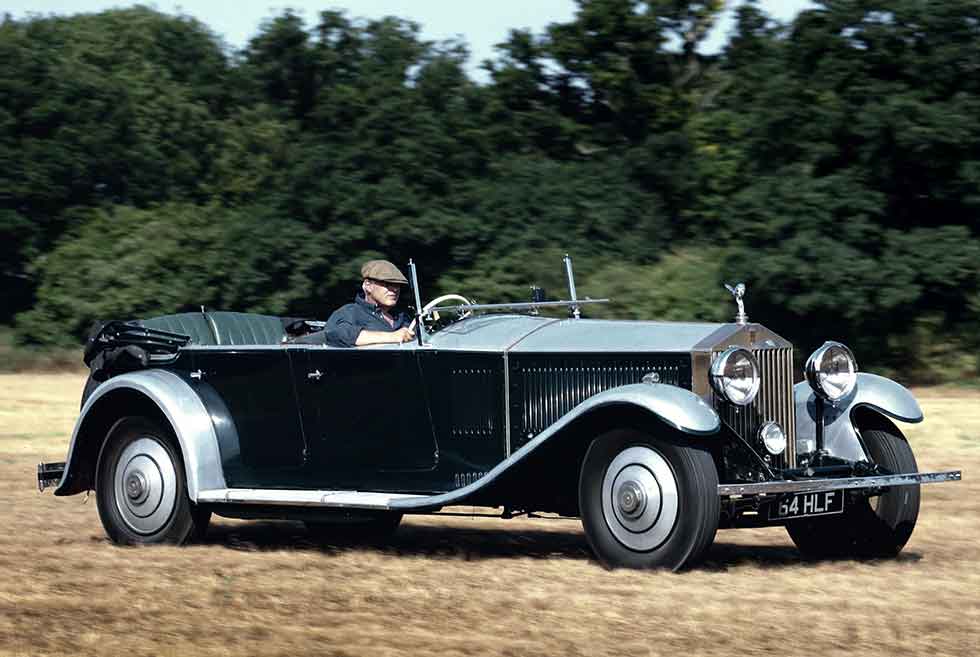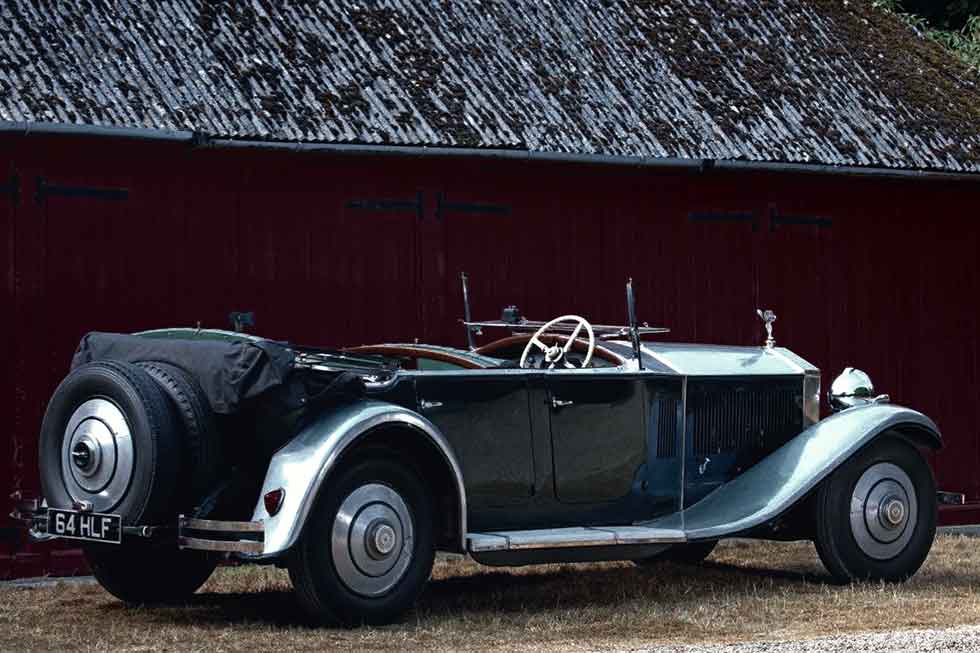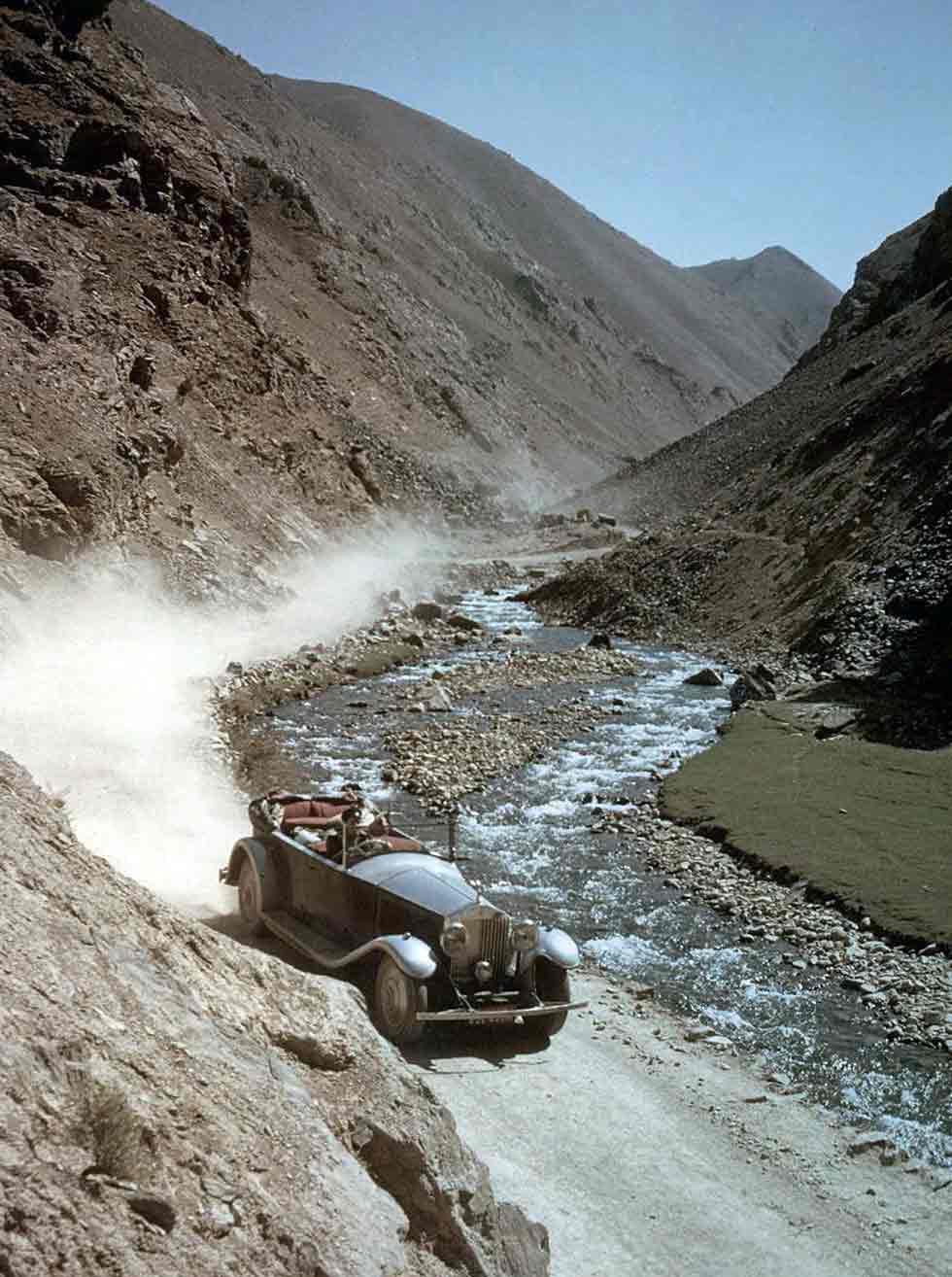
The Incredible Journey Mick Walsh investigates a Rolls-Royce Phantom II with a taste for adventure. A passage from India. Is there a finer steed for a heroic journey across Afghanistan, Pakistan and Iran than a glorious Rolls-Royce Phantom? Words Mick Walsh. Photography James Mann.
EPIC ADVENTURE IN A VINTAGE ROLLS-ROYCE
The long and lean vintage Rolls-Royce tourer purrs across the parched grass on a private airfield in Wiltshire, its tall wheels leaving a dusty trail in its stately wake as shadows stretch in the low evening sun. With screen folded flat and owner Valentine Lindsay at the wheel, the handsome Barker-bodied Phantom II in flight is an impressive sight, even more so when you learn of the imposing car’s remarkable past.

Ordered new by one of India’s royal families, in the early 1960s it was driven back across Pakistan, Afghanistan and Iran by Valentine’s father, the Hon Patrick Lindsay, with the noted archeologist and adventurer Ian Graham alongside him. Since its return to England this wonderful car has become the much-loved and well-used family transport of the Lindsay family, creating a wealth of memories. Few old cars have such a rich history of continued use.
The Phantom II’s style originates from Barker, the Shepherd’s Bush-based coachbuilder that was the fashionable choice for a young maharaja in 1930. Not only was this one of the oldest and finest companies, with prestigious custom from British royalty, but Barker’s workmanship was also both beautifully finished and stylishly designed. Orders from wealthy Indian princes were key to the firm’s survival during the Depression years, as with any coachbuilder, and Barker’s designs ranged from formal coachwork to rakish hunting cars.

Maharaja Sawai Sir Man Singh II of Jaipur was 18 when he ordered a sporting tourer, chassis 22GX, which was signed off from chassis test in October 1930. As with many Indian orders, the dual-cowl tourer had dramatic details including a polished body top, and was finished with nickel plating. The newly completed Phantom II was shipped to Bombay before transport to the Rambagh Palace, the spectacular royal residence just outside the ‘Pink City’ of Jaipur.
The sporting Barker Phantom II joined an impressive collection of cars for use on special occasions and trips to polo games, which were a lifelong passion for the young prince. When the dashing maharaja married the beautiful Gayatri Devi, his third wife, in May 1940, the car was no doubt involved in what was then the most expensive wedding ever staged.
The glamorous Indian royals were regular visitors to England, where their homes included Saint Hill Manor in West Sussex. Even after independence, they remained one of India’s wealthiest families. A keen soldier, pilot and sportsman, Man Singh II continued to indulge in expensive cars and private planes. When the couple hosted a party, whether in England or India, it was a must-attend for high society. Over the years, guests at the Rambagh Palace included the Mountbattens, Jackie Kennedy and Mick Jagger. Presumably after India’s independence in 1947 the old Barker Phantom II became unfashionable and sat gathering dust in the maharaja’s impressive 30-car garage. Its low mileage was mostly completed in first gear, convoying slowly in parades, often behind elephants.
When the Hon Patrick Lindsay started planning a honeymoon with wife Amabel in the winter of 1955, they chose to visit Jaipur, where the couple were hosted at the Rambagh Palace. The groom and Man Singh II were of a similar age, and had doubtless met at parties in London. They shared similar sporting interests, including flying, and had both served with the Guards. During his stay, Lindsay – a keen motorist and lover of fine machinery – was invited into the impressive garage, where the 25-year-old Barker tourer caught his eye.

Having already developed a taste for adventure and great cars, Lindsay asked if the old Royce could be bought, but Man Singh II insisted on offering it as a gift. Surprised by his host’s generosity, Lindsay hatched the mad idea of driving the car to England.
Back home, despite the distractions of a young family, a career with Christie’s Fine Art department, and historic motor racing with a rapidly expanding collection that included the ERA ‘Remus’ and an Alfa Monza, Lindsay never gave up on his Indian adventure. In 1962 he made contact with Graham, his close friend and a real-life ‘Indiana Jones’, about joining him on the road trip. Lindsay was always honest about his lack of mechanical expertise, but thankfully Graham was immensely practical and had already driven a vintage Royce from New York to California via Mexico. The plan had amused Man Singh II, but his wife was convinced the car would fail after 10 miles. Preparations were limited to shipping six new Dunlop tyres to Jaipur and, once Graham had returned from Mayan ruins in Guatemala, the flights were booked to India for September, with Lindsay securing a month’s leave from Christie’s. No doubt his wife Amabel, then eight months pregnant, was used to her husband’s daredevil adventures in various vintage aircraft, historic boats and Brooklands racing titans.

Following a few days of rest as guests in the Rambagh Palace, the pair set out for Delhi – but within 100 miles the car ground to a halt. Graham diagnosed fuel starvation and, after cleaning the pipes and single-jet Rolls-Royce carburettor, they motored on, but the engine soon stopped again. The cleaning procedure continued, with several frustrating stops until cotton waste was discovered blocking the system between the tank and the Autovac.
The 170-mile trip to Delhi was made more fraught by overheating, and after various attempts to clean out the cooling system, Graham insisted they stop in Delhi to find a garage with a hydraulic lift to change all the fluids, including the oil. The sump plug proved impossible to loosen, so the whole plate and 12 securing bolts were removed. To Graham’s horror, when the plate was finally prised off, it was 30 seconds before a thick, treacly goo oozed out. Despite assurances back in Jaipur, it was clear the lubricant hadn’t been changed for years, if ever! The maharaja’s mechanic had simply continued to top up the oil rather than change it, and the concern now was that blocked oilways might cause a big-end bearing failure.
Thankfully, the quality of the Phantom II’s engineering proved resilient against such servicing neglect and the impressive tourer purred on to the Pakistan border. After Lahore, while following a gorge near the River Indus, water levels reached 21/2ft and locals had to be enlisted to push the car through the deep tributary. Graham was worried that water had entered the car’s oil system, but plans for a precautionary change weren’t possible because they didn’t carry enough for a complete refill.
The magnificent Phantom II, by now covered in road dust, took the Khyber Pass in its stately stride, only stopping to admire the historic hillside forts on the famous Silk Road. Once into Afghanistan, the roads to Kabul greatly deteriorated but the Phantom II cruised to the capital without trouble, where Lindsay and Graham enjoyed a welcome two nights as guests of the Indian ambassador. Here, Lindsay learnt of the birth of his third son, Valentine.
Ever adventurous, the intrepid pair ignored advice to take the new road through Afghanistan to Iran via Kandahar. Inspired by travel writer Robert Byron they secured permits for the more challenging northern territory. Concerns about the lack of fuel were resolved by fitting a huge 50-gallon drum in the back seat, but this proved unnecessary – fuel stations were non-existent, but each time they stopped en route to the Iranian border, locals would rush out with tin pitchers and a funnel to refuel from private tanks.
A visit to the legendary Bamiyan cave monastery was now the highest priority and large-scale maps were sourced for the challenge of a minor road up to 11,000ft over the Hajigak Pass. The views were epic as the grand Royce motored on, occasionally passing camel caravans of Kochi nomads heading down to warmer regions for the winter. The pre-war tourer even helped a broken-down bus, the extra weight of the petrol tank in the back seat aiding traction as it towed the local travellers to the top.
The challenging diversion north proved worthwhile when the Rolls arrived at Bamiyan. Both Lindsay and Graham were mesmerised by the 115ft Buddha carved out of the sandstone cliffs and the network of passages decorated with wall paintings. ‘The beauty of the place was unforgettable,’ recalled Graham in his autobiography, The Road to Ruins, ‘but in our ignorance we failed to see the second Buddha.’ Tragically, the huge fourth-century carvings were destroyed with dynamite in 2001 by the Taliban.
Other diversions included the lakes of Band-e Amir before the pair headed up a narrow ravine where the Darya Kunduz flowed. Here, the long car struggled to fit on the narrow bridges. Faced with one impossible crossing, Lindsay and Graham agreed that there was no option but to attempt a high-speed jump. After reversing about a quarter-mile, the Phantom, with both occupants aboard, accelerated to the launch point at full power. The front wheels lifted, but the undertray and brake cables caught the edge of the bridge with a dramatic noise. It skidded to a halt with locked wheels, and the duo feared the worst. Thankfully, upon inspection the wire wheels looked fine. After a some nifty hammer-work, the brakes were released and the Royce motored on to Pul-e Khomri.
The deserts of the Northern Region offered yet another challenge which almost left the car stranded but, again, locals saved the day. On the way to Mazar-i-Sharif, the faint track disappeared completely and, driving into the softer sand, the Phantom became stranded in a very isolated place. The two Englishmen tried to rock the car free but without success. Rationing water and food, Graham and Lindsay anxiously scanned the horizon for hours until, finally, a dusty trail was spotted. At last, a colourfully decorated truck pulled up and the all-male passengers and driver climbed out to investigate. After a struggle to get the travellers to pull the tow rope at the same time, the car was moved closer to the bus and eventually hitched up for the final pull out of the sand. With his smattering of Pashto, Graham encouraged several tribesmen to ride in the Royce just in case they encountered more problems in the sand.
‘The Royce’s low mileage was mostly completed in first gear, convoying slowly in parades, often behind elephants’
The pair motored on across the desert with breathtaking mountain backdrops, passing through Mazar-i-Sharif with its beautiful blue-tiled mosque and later Balkh, one of the world’s oldest cities. Lindsay and Graham reported the Afghans to be friendly and ever-helpful, with the car continually attracting attention but no-one touching it. Later, in Iran, the locals were less respectful, leaving handprints on the polished body. ‘One bystander even kicked the tyre,’ wrote Graham, ‘and exclaimed, “Ah, Ford!”’
The month flew by and, with leave running out, the friends agreed to head across Iran to the port of Abadan and ship the Rolls-Royce home; Lindsay and Graham then arranged flights to return to England. ‘We both derived enormous pleasure from our escapade,’ concluded Graham, who felt privileged to have experienced a ‘Golden Age of modern Afghanistan’ before the recent turmoil rocked the country. ‘It was the greatest trip of my life, so exciting and educative. Other than the oil change the car ran trouble-free for 2500 miles.’
Early in 1963 the Phantom II finally arrived back in England and, other than minor damage incurred when cradled off a ship, the handsome machine was ready for an active new life with the Lindsay family. And while, over the years, other more exotic cars have come and gone from the Lindsay collection, the Barker Phantom II remains a favourite. “Everyone loved it,” Valentine recalls. “We used it for holidays in Scotland, and when visiting my grandparents in Fife we took it for fabulous picnics on the beach. We would all ride on the running boards. It was a real ‘Chitty Chitty’ car for us.”
When Patrick Lindsay died of cancer in 1986, the car collection was divided between his children. “The Rolls was my first choice because I always loved it,” explains Valentine. “Whenever dad drove it, he always cheered up. For me it signified laughter and fun.” Later kept at the family farm in Wiltshire, the Royce never failed to raise spirits when used for trips to the pub with friends, or for clowning around the farm airstrip: “We used to set the hand-throttle control, then climb out the passenger door and work around the rear sets and back into the driver’s seat before we reached the end of the runway. We also used it to tow paraponts after they lifted the rear wheels of our Jeep.”

The Barker Phantom even ventured on track for a race with the VSCC. “I needed a last signature for my international licence, and after problems with the 1914 GP Opel, we asked if the Rolls could be substituted at Silverstone,” remembers Valentine. “Bill Boddy supported our switch and we even removed the Flying Lady for lightness.” The all-comers event featured a diverse range of cars, from Austin Sevens to Bentleys: “We were lapped on the first circuit but every time we passed the packed grandstand there was a big cheer. Neil Corner said it looked like a huge shark among little fish, but it went well with a 51mph lap. Keith Schellenberg had a bit of a scare in the Barnato-Hassan Bentley when he had to pass me on the grass around the outside of the old Woodcote.”
At Valentine’s wedding in 1990, special guests included none other than Gayatri Devi. The Phantom was, of course, enlisted as the wedding car, which greatly impressed the famous maharani. “I think it’s time I had my car back,” joked ‘Aisha’ to the groom. “Only if you drive it back to India,” laughed Valentine in response. With a two-family ownership from new, the very special 1930 Barker Phantom II continues to bring great joy to a third generation of the Lindsay family, and still evokes memories of that awe-inspiring journey.
‘Faced by one impossible bridge, Lindsay and Graham agreed that there was no option but to attempt a high-speed jump’





